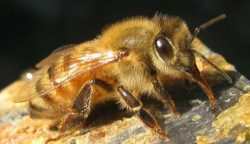One of the smartest men to ever live once said, “If the bees disappeared off the face of the Earth, man would only have four years left to live.” Albert Einstein was addressing threats to honey bees. Honey bees are an essential part of our ecosystem, from pollination to producing honey, they play a necessary role in our everyday lives.
Let’s BEEgin with pollination:

Bee pollinating a flower. Source: Independent News UK
The vast majority of plant species, almost 90%, rely on pollinators to reproduce (WE). Pollination is the process by which pollinators help plants to produce fruit by transporting pollen from one flower to another (WE). There are approximately “200,000 different species of animals around the world that act as pollinators.”(WE). Honey bees are among the most numerous and efficient pollinator species in the world. Considering that the average honey bee can visit more than 2,000 flowers in one day, these bees greatly increase the chances of a plant producing a fruit or vegetable. Recently, the honey bee population has declined.
Could this BEE the end?
There is a strong scientific consensus that bees are in decline, but the reasons require further study. This decline has been linked to several factors, including parasites such as Varroa mites, the use of pesticides, and starvation. I had the opportunity to interview Maureen Jais-Mick, a member of the Montgomery County Beekeepers Association, who gave insight on these threats. According to Ms. Jais-Mick, “Varroa mites are external parasites that attack both adult honey bees and unborn bees. They suck the blood from the bees which then weakens or kills the bee.” These parasites can affect the entire colony leading to colony collapse.

Close up of a honey bee. Source: Storm the Castle
Another factor is the use of pesticides. Pesticides, herbicides and fungicides are widely used in commercial agriculture and by homeowners, who are uneducated about the essential role insects play in maintaining a healthy landscape. Ms. Jais-Mick states that, “Chemicals can not only kill beneficial insects such as honey bees, but bees can pick up chemicals from plants on which they forage and bring them back to the hive, thereby poisoning their sisters.” Which bring us to the last threat, starvation. Ms. Jais-Mick stated that in Montgomery County, “we have a short nectar flow, about 45 days. The nectar flow is the time of year when the native vegetation is in full bloom.” In the mid-Atlantic, it begins mid-April or early May, when the trees begin to flower, and continues through May to early June with blooming shrubs. This is a relatively short “nectar flow.” The Montgomery County Beekeepers Association, “encourage folks to focus on pollinator-friendly plants in their gardens so that there is some food for honey and native bees throughout the year.” The threats are prominent to all honey bees solutions are readily available.
BEE positive:
There are new ideas that are available in the last few years to prevent the death of honey bees. One of the many new solutions is “miticides (chemicals that kill mites)”. These Miticides are placed near areas that have bee hives and are able to kill the Varroa mites before they infect the colony. Another solution is using eco-friendly pesticides such as neem oil, vinegar, epsom salt, chrysanthemum and essential oils. These naturally repel insects and they do not harm the plants that bees feed off of, therefore they are better for the environment.
Could this BEE a happy ending?
There are many ways to reduce threats to honey bees, but where do we go from here? There are many ways for local patrons to help. The easiest way to save the bees is habitat protection. Make sure to plant native bee friendly plants and flowering herbs, don’t use pesticides and chemicals to protect your garden, put a small basin of water outside because even bees get thirsty. Another way to get involved is to shop at farmers markets that support local beekeeper companies, and donate money to companies such as the Beekeeper’s Association of Montgomery County, and other local organizations that work to help and protect bees. And last but not least, it is always important to involve your local representatives by making them aware of the issue. Check out ways to speak out for bees by using the Works Cited section below.

Honey bees in their honeycomb. Source: ThoughtCo
Overall, it is a necessity to protect bees. Without bees, we would only have four years to live, according to Albert Einstein, and we need to protect them for our future generations. If you can help in anyway, please do and don’t worry BEE happy because it’s not too late to save the bees!
Written by Katia Goldberg, Walt Whitman High School
Works Cited:
Ten things you can do to help bees. Retrieved December 06, 2017, from http://www.queenofthesun.com/get-involved/10-things-you-can-do-to-help-bees/
WE NEED BEES. Retrieved December 06, 2017, from https://www.planetbee.org/why-we-need-bees/
Home. Retrieved December 06, 2017, from https://montgomerycountybeekeepers.com/
Jais- Mick, Maureen. “Honey Bees.” 26 Nov. 2017
Hadley, D. 10 Fascinating Facts About Honey Bees. Retrieved December 11, 2017, from https://www.thoughtco.com/fascinating-facts-about-honey-bees-1968071
Connor, S. (2015, June 16). Wild bees ‘just as important as honeybees’ for pollinating food crops. Retrieved December 11, 2017, from http://www.independent.co.uk/news/science/wild-bees-found-to-be-just-as-important-as-honeybees-for-pollinating-food-crops-10324450.html
Mead Stuff-. (n.d.). Retrieved December 17, 2017, from http://www.stormthecastle.com/mead/bees-honey/pictures-of-bees.htm





